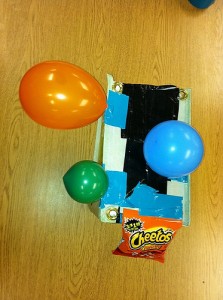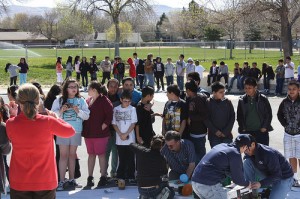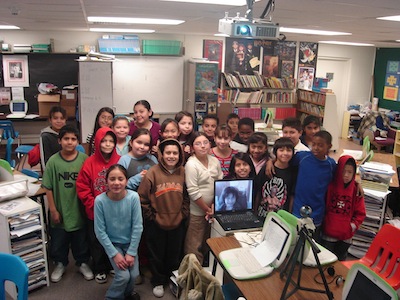 30-year veteran Brian Crosby teaches the upper elementary grades (4-6) in Sparks, Nevada. He has infused technology into teaching since the 1980’s and his students (many of whom are “at risk”) regularly utilize Web 2.0 tools including Skype, Flickr, blogs and wikis. He’s presented at TEDxDenver and TEDxNewYork. Brian blogs at Learning Is Messy and at The Huffington Post, where these thoughts first appeared in two separate posts. They’re linked together here by a brief comment from Brian’s personal blog.
30-year veteran Brian Crosby teaches the upper elementary grades (4-6) in Sparks, Nevada. He has infused technology into teaching since the 1980’s and his students (many of whom are “at risk”) regularly utilize Web 2.0 tools including Skype, Flickr, blogs and wikis. He’s presented at TEDxDenver and TEDxNewYork. Brian blogs at Learning Is Messy and at The Huffington Post, where these thoughts first appeared in two separate posts. They’re linked together here by a brief comment from Brian’s personal blog.
Innovation Starts with Having Autonomy
One of the most infuriating aspects of the discussion about education reform or change has been that there really hasn’t been a discussion. Money and power have trumped experience for far too many years now with the media and the U.S. Department of Education rushing uncritically to get every quote and opinion from billionaires and politicians, while worse helping them label anyone with an opposing or experienced opinion as being for the “status quo” or not having the best interests of children in mind.
Media is often behind on issues like this and rush to celebrities for opinions because it is easier and cheaper than actually digging and asking the hard questions. That seems to have changed recently with the testing and data collecting scandals, and the failure of vouchers and corporate model charter schools to “fix” education. And note I am not at all against charter schools, in fact I am a full-time public school district teacher and I sit on the board of a local charter school. The charter school concept has been hijacked by some with money to push a very narrow model that has unfortunately poisoned the charter school concept in many peoples’ minds.
Perhaps, though, the biggest stretch of the facts that “reformers,” including the Department of Education for over ten years, have successfully foisted on society has been that their methods are models of “innovation.” I’m generalizing here some, but typically the models for education they promote look like school has for well over a hundred years. Sit kids in rows, sit up straight, be quiet, memorize facts, stick to a readin’, ‘riting, ‘rithmetic type of narrow curriculum and so on. And there might be a small percentage of students that that would help, much the same as “boot camp” style schools for troubled youth end up helping some, but that doesn’t make them the right fit for every child, and it certainly doesn’t make them “innovative.”
One thing the current “reformers” have right is that we should be innovating. We should be learning from innovative teachers, schools, programs and countries already showing success, as well as promoting real innovation through our policies and investments. Currently “Race to the Top” makes it very difficult to really innovate because it demands conditions that support too narrow an approach. It actually stifles true innovation.
Innovation in education is not going to happen in the “top-down” model currently being overly encouraged and even enforced on teachers and schools. Teachers and other experienced educators should be driving innovation, but they are being shackled with programs, requirements and “we know better” than you attitudes. By the way this also makes it more difficult to hold teachers accountable. Teachers are learning to embrace “programs” because then any failure (if I’ve followed the program) is mostly the program’s fault.
If we give teachers the responsibility, the time and most importantly the autonomy to design, implement, evaluate, tweak and improve their pedagogy and curriculum, that is when we will really see innovation happen.
When Finland saw its schools failing 10+ years ago they did not go to a “no excuses” test everything approach. They didn’t fire teachers and blame teachers. They gave teachers the responsibility and the support to change their schools. Teachers took on their professional development, training and peer review, and the school administration was there to help get the resources and time to make it happen. They turned our current top/down model on its head and transformed their schools. Administration is there to support what teachers and students need to learn instead of telling them what to do.
No, we are not Finland, and yes, we have issues they do not, but that shouldn’t change the basic approach. What they found (and schools here that have autonomy found long ago) was that teachers won’t put up for long with colleagues that are not pulling their weight, and that others blossomed when given quality, ongoing training and support in what they do (what a concept).
If we truly want to foster innovation in and from America’s schools. If we want schools that foster engagement and creativity, an important step will be to give teachers and schools the autonomy and time to build great schools from the ground up. If some of those are charter schools, great, but non-charter public schools should be at the forefront as well. The technology available to us now that connects us all in new powerful ways will leverage what teachers can do and plan by including successful colleagues globally in making and incorporating genuinely innovative practices. Put actual experienced educators in charge; they are the heart of real reform.
It’s Not Basics THEN Enrichment
When my Huffington Post post “Innovation Starts With Having Autonomy” published, John Thompson left a comment there that reminded me of a quote I’ve used in the past. It is from Renee Moore’s blog where she quotes David B. Cohen, who teaches at the upscale Palo Alto High School in CA :
What I wish people would realize is that “good” schools with high test scores don’t think of their instruction as some kind of reward for the test scores. They don’t focus on basic skills and then suddenly reach a point where they…develop deeper knowledge, enrich learning, engage students’ interests, etc. It’s not basics and then enrichment. The basics can be addressed more covertly, more authentically, and more effectively, when those skills are developed in a meaningful and motivational context. That type of environment shouldn’t be the exception, the unearned privilege of the children of privileged parents, and those lucky enough to attend schools that test well. That type of education is the birthright of every child.
Learning is messy!
Models of Education Innovation: What Else Should We Try?

The payload prepared by Crosby's fifth grade science students, ready for high altitude balloon launch.
In comments on this and other blogs about education, one of the constant complaints from commenters is that no solutions are proposed, only reasons why some program or policy won’t or doesn’t work. These are frustrating and non-productive since usually the solution is implied (if too much testing is the issue, less testing is part of the solution for example. If very regimented models are being railed against, then less regimented is what is being promoted). I decided sharing some ideas might be productive. I provide just a brief synopsis of each.
We have KIPP, other charter schools and regular public schools trying that model, and it is the model that Race to the Top seems too laser-focused on, let’s try other things too. Here are just some ideas, this is by no means an exhaustive list, add your own in the comments. Some of these ideas would be expensive and others less so. My goal was a great education, not less cost, although if any of these models are found to be successful, cost savings might be realized over time or perhaps thought worth the investment. NOTE: I’m an elementary teacher, so my ideas are influenced greatly by that.
- If too many bad teachers are the real reason why children do poorly in school, here is an approach to ferret that out. Since the promoters of this thinking claim that if we just put a great teacher in a classroom they can overcome poverty, health, language issues and more, let’s spend some of the Race to the Top money to find out for sure (and maybe Gates or Broad or someone else could support this too). Let’s assemble a staff of great teachers (award winners? Teachers whose students have great test scores?) and have them take over a high poverty elementary school with horrid scores, for example, and give them 3 to 5 years to turn the school around. To make this model legit, no other funds or special programs, extra staff or health care beyond what is already funded by the school district or grants already in place (because remember, it’s just about the teacher) can be utilized.
- Let’s try schools that follow the “bottom to the top” model where teachers and other educators on-site have most of the responsibility and autonomy to design the curriculum, pedagogy, assessment and professional development (training). The administration is there mostly in a support role to gather resources, advise and provide other support. Since the teachers/educators at each site make the decisions on what pedagogy and materials they will use, this will look different at different sites. This is a benefit since what each site finds works and doesn’t work can and should be shared.
-

Students talk with U of Nevada scientists as they prepare ballon for launch in the school playground
Models that include the example above and provide a broad, rich curriculum for all students starting in pre-school, including science, social studies, physical education, field-trips, during and/or after-school sports programs, arts programs, literacy, health and counseling programs for students and families (as opposed to a narrower curriculum offered in too many schools under NCLB). In addition, since research shows easy access to lots of books makes a huge difference in student reading ability, students in the school (and their families, including pre-school age children) will receive libraries of books for their homes (which would be collected and recycled to others over the years), each classroom and the school library will be very well stocked and updated with books.
- Technology should be ubiquitous and students should be taught to use it as a tool for learning, exploring, connecting, collaborating and becoming learners. Ethics, safety and responsible use would be taught and discussed daily. Some schools in this model could also try extending the school year and include outdoor education and sports leagues (maybe run by the parks and recreation department). Some of the health monitoring and care may be covered already when the new health care program is fully implemented. This model might be the closest to what they do in Finland, which is the highest scoring country in the world according to PISA scores. I model this approach somewhat during a TEDx talk I gave in Denver in 2010.
- Re-draw boundary-lines in school districts to make schools as diverse as possible, socio-economically and otherwise. There is research that shows that diversity helps everyone. There are plenty of school districts, especially large districts, where it would be fairly easy to try this intervention on a smaller scale at first. For example, in my school district there are schools where higher socio-economic schools and a lower socio-economic schools already border on each other so long distance busing would not be required, and many students could still walk.
-
All the models above should be tried with ongoing professional development decided by what teachers require to support their teaching.
- Hybrid approaches using combinations of the above ideas should be tried as well.
- Any of the models above could (really should) include paying teachers to spend more contract days collaborating, planning and preparing lessons and receiving professional development before and during the school year.
- Assessment of each model could be done through observation, NAEP, PISA, or other assessment.
OK, now please add your ideas (the flipped model or anything else) in the comments.
Brian Crosby
Latest posts by Brian Crosby (see all)
- Sharing Real-World Projects Sharpens the Literacy Skills of Connected Students - October 24, 2013
- Going Deep: STEM in the Connected Classroom - March 15, 2013
- My Voice for Change: Muted, But Not Silenced - July 6, 2012



